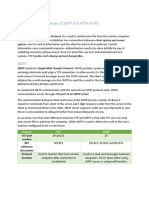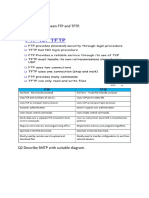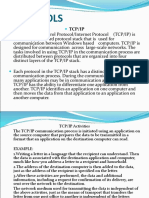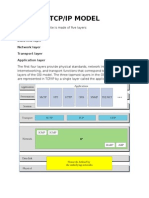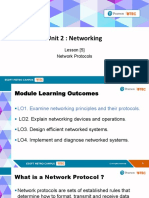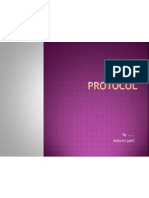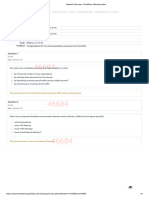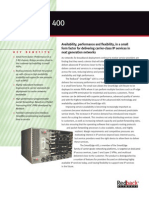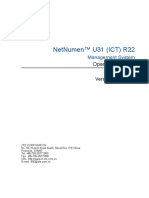Network Protocols:
In networking, a protocol is a standardized set of rules for formatting
and processing data. Protocols enable computers to communicate
with one another.
A network protocol is an established set of rules that determine how
data is transmitted between different devices in the same network.
Essentially, it allows connected devices to communicate with each
other, regardless of any differences in their internal processes,
structure or design.
TCP:
Transmission Control Protocol (TCP):
Function: Ensures reliable, ordered, and error-checked delivery
of data between applications. TCP establishes a connection
between the sender and receiver before data is sent.
Key Features:
o Connection-oriented: Establishes a connection before
transmitting data.
o Reliability: Ensures that data is delivered accurately and in
the same order it was sent.
o Flow Control: Manages the rate of data transmission to
prevent overwhelming the receiver.
o Error Detection: Detects errors in transmitted data and
ensures it is retransmitted if needed.
Use Cases: Web browsing (HTTP/HTTPS), email (SMTP), file
transfers (FTP).
�IP:
Internet Protocol (IP):
Function: Handles the addressing and routing of data packets
so that they can travel across networks and arrive at the correct
destination.
Key Features:
o Connectionless: Does not require a connection to be
established before sending data.
o Packet Routing: Directs packets of data from the source to
the destination based on IP addresses.
o Addressing: Assigns unique IP addresses to devices on a
network.
TCP/IP is the backbone of internet communication, enabling reliable
data transfer across diverse networks. It combines the robust,
connection-oriented TCP with the versatile, connectionless IP, making
it suitable for a wide range of applications and services that we rely
on daily.
HTTP:
Stateless Protocol:
Stateless: Each HTTP request from a client to server is
independent, meaning that the server does not retain any
information about previous requests.
� Implication: Every time a client (such as a web browser) makes
a request, the server processes it as if it is the first request from
that client.
Client-Server Model:
Client: The client (typically a web browser) initiates a request to
the server for resources like HTML files, images, or videos.
Server: The server processes the request and sends back the
requested resources or an error message if something goes
wrong.
Request-Response Cycle:
Request: The client sends an HTTP request to the server, which
includes methods like GET, POST, PUT, DELETE, etc., specifying
the action to be performed.
Response: The server responds with a status code (like 200 for
success, 404 for not found) and the requested content or an
error message.
Difference b/w:
HTTP:
Data transmitted in plain text.
Vulnerable to eavesdropping and attacks such as man-in-the-
middle (MitM).
HTTPS (HTTP Secure):
Data is encrypted using SSL/TLS, providing a secure channel
over an insecure network.
Protects the integrity and confidentiality of data during
transmission.
Use Cases
� Web Browsing: Loading web pages, including fetching
resources like images, scripts, and stylesheets.
APIs: Communicating between web services and applications,
often using RESTful services.
Form Submissions: Sending form data to a server for
processing.
HTTP is the essential protocol for the web, facilitating the
communication between clients and servers. While it started as
a simple protocol for transmitting hypertext documents, it has
evolved to support complex interactions and secure
communication through HTTPS
FTP:
File Transfer Protocol:
Client-Server Model:
Client: The user’s device (e.g., a computer or smartphone) that
initiates the file transfer.
Server: The remote machine that stores the files and responds
to the client's requests.
Authentication:
Anonymous FTP: Allows users to access files on a server
without needing a username or password. This is common for
public file repositories.
Authenticated FTP: Requires a valid username and password to
access files. This is typical for private servers or when security is
a concern.
Modes of Operation:
� Active Mode: The client opens a port and listens while the
server actively connects to it. The server initiates the data
connection.
Passive Mode: The client initiates both the command and data
connections, making it more firewall-friendly, as the client does
not need to accept incoming connections.
File Transfer:
Binary Mode: Transfers files as raw binary data. This is used for
non-text files like images, videos, and executable files.
ASCII Mode: Transfers files as plain text. This mode is used for
text files and can adjust for different line-endings on different
systems (e.g., Windows vs. Unix).
Commands and Responses:
Commands: FTP supports various commands for file
management, such as GET (download a file), PUT (upload a file),
DELETE (remove a file), MKDIR (create a directory), and LIST (list
files in a directory).
Responses: The server sends numeric codes to indicate the
status of the command, such as 200 (command successful), 530
(authentication required), or 550 (action not taken, typically
due to a file not being found or permission denied).
How FTP Works
1. Connection Establishment:
o The client connects to the FTP server using the server's IP
address or hostname, along with the port number (usually
port 21).
o The client authenticates with a username and password
or uses anonymous access.
�2. Command and Data Channels:
o Command Channel: Used for sending commands from the
client to the server and receiving server responses.
o Data Channel: Used for transferring files between the
client and server.
3. File Transfer:
o The client navigates the server's directory structure and
initiates file uploads or downloads.
o Files are transferred over the data channel, either in
binary or ASCII mode.
4. Connection Termination:
o Once the file transfers are complete, the client can close
the connection.
Advantages of FTP
Large File Transfers: FTP is efficient for transferring large files or
large numbers of files.
Resumable Transfers: If a file transfer is interrupted, FTP can
resume the transfer from where it left off (supported by some
clients).
Directory Management: FTP allows users to manage files and
directories on the server, such as creating or deleting
directories, and moving files.
FTP is a robust and widely-used protocol for transferring files
across networks. There are secure versions of FTP such as FTPS
or SFTP
SMTP:
� Key Features of SMTP
1. Client-Server Model:
o Client: The device or application that sends the email
(e.g., an email client like Outlook or a web-based email
service).
o Server: The mail server that handles the transmission and
delivery of emails.
2. Connection-Oriented:
o SMTP operates over a reliable, connection-oriented
service (usually TCP), ensuring that messages are
delivered in sequence and without errors.
3. Text-Based Protocol:
o SMTP uses plain text commands and responses to
facilitate communication between the client and server.
4. Push Protocol:
o SMTP is a "push" protocol, meaning it is used to push or
send emails from the client to the server and from one
server to another.
5. Works with Other Protocols:
o SMTP is primarily used for sending emails. To retrieve
emails, other protocols like POP3 (Post Office Protocol 3)
or IMAP (Internet Message Access Protocol) are used.
1. Email Composition:
o The user composes an email using an email client or a
web-based service.
2. SMTP Client Initiates a Connection:
� o The email client connects to the SMTP server using the
server's IP address or domain name (typically on port 25,
465, or 587).
3. SMTP Commands:
o The client sends a series of commands to the SMTP server
to transfer the email:
HELO/EHLO: Initiates the conversation with the
server, identifying the client.
MAIL FROM: Specifies the sender's email address.
RCPT TO: Specifies the recipient's email address.
DATA: Indicates the start of the email message
content, including headers (like subject, sender,
recipient) and the body of the email.
QUIT: Ends the conversation between the client and
server.
4. Server Response:
o The SMTP server responds to each command with a status
code (e.g., 250 for successful commands, 550 for failed
commands).
5. Forwarding to Recipient's Server:
o If the recipient is on a different domain, the SMTP server
forwards the email to the recipient's mail server using the
same SMTP protocol.
6. Email Delivery:
o The recipient's mail server stores the email until the
recipient retrieves it using a protocol like POP3 or IMAP.
Advantages of SMTP
� Simplicity: SMTP is a straightforward and widely adopted
protocol, making it easy to implement.
Reliability: It ensures that emails are delivered reliably, with
built-in mechanisms for error handling.
Interoperability: Works well with other protocols like POP3 and
IMAP to provide a complete email service.
Use Cases
Sending Emails: SMTP is used by email clients to send outgoing
emails to a mail server.
Server-to-Server Email Transfer: It is used to transfer emails
between different email servers across the internet.
Automated Systems: Applications and systems use SMTP to
send alerts, notifications, and reports via email.
SMTP is a fundamental protocol in the email communication
process, responsible for the reliable and efficient transfer of
emails from one server to another or from a client to a server.
The secure versions of SMTP are STARTTLS and SMTPS.
IMAP:
Key Features of IMAP
1. Server-Side Storage:
o Emails are stored on the server, allowing access from
multiple devices (e.g., a smartphone, tablet, and
computer).
o Changes made to emails (e.g., reading, deleting, or
moving emails to folders) are synchronized across all
devices.
2. Multiple Folders and Labels:
� o IMAP supports multiple folders and labels, which can be
managed and synchronized across devices.
o Users can organize their emails on the server, and the
organization is reflected across all connected devices.
3. Partial Download:
o IMAP allows the client to download only the headers of
emails (subject, sender, etc.) first, and the body of the
email can be downloaded when the email is opened. This
is useful for managing bandwidth.
4. Offline Access:
o Some email clients using IMAP can cache emails locally for
offline access. However, changes made offline are
synchronized when the client reconnects to the server.
Advantages of IMAP
Synchronization: IMAP provides seamless synchronization
across multiple devices.
Server-Side Management: Emails remain on the server, so they
can be accessed and managed from anywhere.
Efficient for Large Inboxes: Users can search and manage
emails directly on the server without downloading everything.
Use Cases for IMAP
Ideal for users who access their emails from multiple devices
and need synchronization across all devices.
Suitable for managing large volumes of emails with server-side
organization.
POP:
�Key Features of POP
1. Local Storage:
o Emails are downloaded from the server to the client’s
local storage. By default, they are deleted from the server
after download, although some clients allow keeping a
copy on the server.
o This makes emails available offline without needing to
stay connected to the server.
2. Single Device Use:
o POP is designed for accessing emails from a single device.
Since emails are downloaded and removed from the
server, accessing the same email from another device can
be difficult.
3. Simple Protocol:
o POP is simpler and uses fewer server resources since it
does not need to synchronize emails across multiple
devices.
Advantages of POP
Offline Access: Once emails are downloaded, they are stored
locally and can be accessed without an internet connection.
Server Space: Since emails are typically removed from the
server after download, server storage is conserved.
Lower Bandwidth Use: POP uses less bandwidth as emails are
downloaded once and stored locally.
Use Cases for POP
Best suited for users who access their email from a single
device and prefer to store emails locally.
� Suitable for situations where internet access is limited, and
users need full access to their emails offline.
Difference b/w:
IMAP:
Storage: Emails stored on the server.
Synchronization: Yes, across multiple devices.
Access: Multiple devices.
Use Case: Users who access email from various devices and
want their inbox to be synchronized everywhere.
POP:
Storage: Emails downloaded to local storage.
Synchronization: No, typically no synchronization across
devices.
Access: Primarily for a single device.
Use Case: Users who primarily use one device for email and
want to keep a local copy of their emails.
Understanding these differences helps in choosing the right protocol based on
individual needs and usage patterns.




















